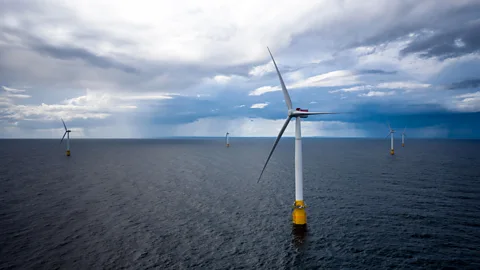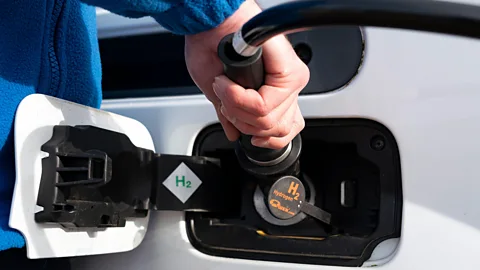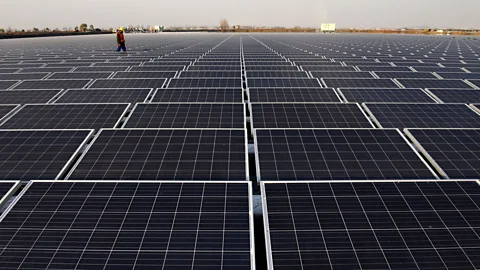 Statoil/Oyvind Gravas/Alamy
Statoil/Oyvind Gravas/AlamyWith the world attempting to reach net zero by the middle of this century, what sources of energy could feasibly replace fossil fuels?
Sixteen miles (26km) off the windswept coast of northern Scotland, the future of renewable energy is taking shape. Rotating rhythmically in the breeze, the five colossal turbines of the Hywind Scotland wind farm look much like any other off-shore wind project, bar one major difference – they’re floating.
While conventional offshore turbines sit atop metal and concrete towers fixed into the seabed, Hywind’s turbines rest on buoyant steel keels that bob with the waves. Carefully balanced, they remain upright despite the undulating conditions. This simple sounding, yet devilishly complex design is changing the way green developers view offshore wind.
To cut those emissions, green electricity will need to be at the core source of global energy, according to the International Energy Agency. It says that by 2040, half of the world’s energy needs will have to be met by electricity produced in a net zero way.
With growing numbers of electric vehicles, combined with increased demand for electricity to replace fossil fuels in domestic and industrial uses, electricity networks will also need to become far more flexible with more ways to generate and store energy. It means that by 2045, our energy network could look radically different to the way it does today.
Projects like Hywind’s floating wind farm offer a present-day glimpse of what that future could look like.
The reasons for this are two-fold. Firstly, unlike fixed units, floating turbines can operate in deep waters far from the shoreline, where winds tend to be stronger and more consistent. Many of the globe’s most densely populated coastal regions straddle these deep waters, according to Henrik Steisdal, a Danish inventor at the forefront of floating wind innovation. He says this gives floating wind another advantage – it can serve communities that currently don’t have much meaningful wind power capacity.
2045: Memories of the Future
This article is part of 2045: Memories of the Future, a multimedia series by BBC Future and BBC World News that examines how much the world will have to change by the year 2045 if it is to reach net zero by the middle of the Century and so keep climate change to within the 1.5C target set by the Paris Agreement on Climate Change.
“Several countries have big offshore areas close to their population centres, but at depths that are simply too large for bottom-fixed turbines,” explains Steisdal.
“In places like Korea, Taiwan, Japan and California, you can only manage a moderate amount of conventional offshore wind, or maybe even none at all, so floating turbines are the only option in the longer term.”
The price of floating wind projects is also still high – costing almost twice as much per megawatt hour of electricity produced compared to bottom-fixed offshore wind. But those costs are expected to drop as the technology becomes more established, as has been seen with other wind energy projects.
But as one question is answered – how to harvest winds from deep, distant waters – another arises: what to do with the electricity generated?
Grid constraints have long been a problem for wind power developers, with fears of a system overload when conditions are particularly blustery. To avoid this, turbines are routinely powered down, a costly process known as curtailment. And what happens in those periods when the wind isn’t blowing hard enough? Add in the logistical challenge of laying dozens of miles of subsea cables, and it’s clear another approach is needed.
Enter hydrogen, the Universe’s most abundant element and – for many – the key to the future of floating wind.
“If it’s especially windy outside and you’ve got surplus electricity being generated, there’s an alternative to shutting the system off,” says Scott Hamilton, renewables division manager at Xodus, an energy consultancy. “Rather than waste those extra electrons, they can be used to create hydrogen fuel.”
Doing so requires an electrolyser – a machine that splits water into its component parts: oxygen and hydrogen. When renewable sources are used to power this process, the latter is referred to as “green hydrogen”.
 Iain Masterton/Alamy
Iain Masterton/AlamyFundamental to this is the fact hydrogen can be stored – compressed and pumped into tanks, it can be transported much like petrol or diesel. This is why floating wind developers are so intrigued.
Attached to the buoyant base of the turbine, an electrolyser could put the wind-generated electricity to immediate use, producing green hydrogen from desalinated seawater. The process would be unhindered by grid concerns and curtailment calculations, with hydrogen output ramping up in response to the strongest winds.
A number of energy firms are pushing this technology, with one developer, ERM, hoping to have a prototype up and running as early as the mid-2020s.
Once up and running, there’s huge scope for how floating wind-generated green hydrogen might be used. As a fuel for vehicles, analysts such as Jess Ralston of the Energy and Climate Intelligence Unit say it lends itself well to heavy-duty, long-range transport – road, rail, maritime, and even possibly air travel. This would allow hydrogen to fill the gaps where electricity generation cannot be used by the middle of the century.
 AFP/Getty Images
AFP/Getty Images“It’s not too hard to imagine a situation where a country with large floating wind capabilities sells green hydrogen abroad, shipping it in huge oil tanker-style vessels or via undersea pipelines,” says James Walker, hydrogen development manager at the European Marine Energy Centre. “We could even have a situation where electrolyser-equipped floating wind turbines serve as refuelling stations for long-distance ships.”
It means that to meet sweeping net zero targets, all sorts of sustainable advances will need to be made. Widespread solar power production, new ways of harnessing marine and geothermal energy, and breakthroughs with biofuel and battery technologies are all going to play their part.
But alongside these ascendant eco-innovations, floating wind and green hydrogen will find their place, helping pave the way towards net zero emissions, and a future powered by carbon-free fuel.




